|
Pyramids of Egypt
Time Travel to the Pyramids of Egypt and The Great Pyramid
by time traveler/futurist
Gordon-Michael Scallion
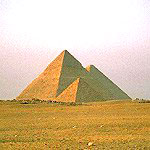 Considered one of the seven wonders of the world, the
Great Pyramid,
located at Giza (also known as the Pyramid of Khufu, the Egyptian
king for which it was built, or Cheops, to use his Greek name), has
stood as an enigma for thousands of years. And it continues to do
so, even in our technologically advanced twentieth century. Considered one of the seven wonders of the world, the
Great Pyramid,
located at Giza (also known as the Pyramid of Khufu, the Egyptian
king for which it was built, or Cheops, to use his Greek name), has
stood as an enigma for thousands of years. And it continues to do
so, even in our technologically advanced twentieth century.
We have built space ships that have transported men safely to the
moon and back, and still, with all of this marvelous technology, we
do not know how the Great Pyramid was built, who built it, and most
importantly, why it was built.
Egyptologists currently date the construction of the Great Pyramid
at around 2,600 B.C., as a tomb built for the pharaoh, Khufu. They
theorize that a primitive people working with copper and brass tools
constructed this monument, using a hundred thousand or more slaves
over a period of twenty years.
Let’s look at some of the scientifically known facts about the
Great
Pyramid, beginning with its location, or position, on the Earth. If
we were to look at a flat map of the continents and oceans, we would
find that Cheops is located precisely at the geographical center of
the total land surface of the world — at approximately thirty
degrees north latitude, by thirty degrees east longitude. Further,
we would find that the pyramid’s position, relative to true north,
is only six seconds of one degree off of today’s exact polar north
direction.
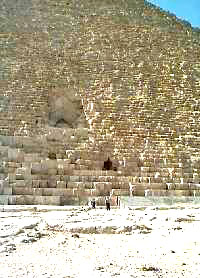 The
Great Pyramid is constructed of almost two and a half million
blocks of stone, each weighing at least two tons, with some stones
estimated at over fifty tons. (For comparison, the average weight of
an American automobile is approximately two tons.) These massive
blocks were cut, moved, and then fitted together with such exactness
that a thin blade cannot be inserted between them. The pyramid has a
vertical elevation the equivalent of a forty-story skyscraper — over
four hundred feet. Currently, no capstone exists on the structure,
and much debate exists as to whether one ever did exist. The base of
this massive monument measures over seven hundred fifty feet on each
of its four sides, and covers an area of thirteen acres. (Again, as
a comparison, an average city block in New York City covers just
under two acres.) The four sides of the pyramid are perfectly
oriented towards the cardinal points — north, south, east, and west.
The base is level with a divergence of less than one inch in its
total circumference. The
Great Pyramid is constructed of almost two and a half million
blocks of stone, each weighing at least two tons, with some stones
estimated at over fifty tons. (For comparison, the average weight of
an American automobile is approximately two tons.) These massive
blocks were cut, moved, and then fitted together with such exactness
that a thin blade cannot be inserted between them. The pyramid has a
vertical elevation the equivalent of a forty-story skyscraper — over
four hundred feet. Currently, no capstone exists on the structure,
and much debate exists as to whether one ever did exist. The base of
this massive monument measures over seven hundred fifty feet on each
of its four sides, and covers an area of thirteen acres. (Again, as
a comparison, an average city block in New York City covers just
under two acres.) The four sides of the pyramid are perfectly
oriented towards the cardinal points — north, south, east, and west.
The base is level with a divergence of less than one inch in its
total circumference.
Whatever culture built the Great Pyramid must have had an advanced
knowledge of mathematics and Earth’s measurements, as well as their
exact position — within seconds of a degree — relative to the North
Pole. One has only to visit this structure to realize it must surely
have been built by an advanced race of people. Its perfection is
like nothing found in the world today.
Conventional Egyptology theorizes that the Great Pyramid is four
thousand six hundred years old, which is in itself an enigma. We
know from archaeological discoveries that copper and bronze were
used at that time, but not iron. Yet even today, to cut these stones
to such an accuracy — especially the granite used in the inner
chambers — would require tools of the precision used to cut
diamonds, but on a massive scale. The engineering, mathematics and
technology needed to construct such a monument is, even now, far
beyond our comprehension. In fact, some years ago, an attempt to
construct a small-scale model of Cheops was attempted. With funding
from Japan, researchers, mathematicians, computer experts, engineers
of all types, machinery, and anything else the twentieth century
could offer were brought to the Giza Plateau. After months of hard
labor and millions of dollars, they gave up. Even with all of the
global technology of the twentieth century at their disposal, all
they could say was, "How did they do it?"
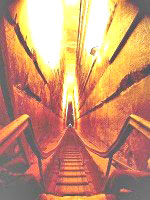 After visiting the
Great Pyramid, I wondered if those who believe a
primitive culture built the Great Pyramid have ever been inside the
structure. If the sheer size and perfection of the outside doesn’t
astound you, the inside surely will. My visit inside the Great
Pyramid and into the Grand Gallery
(click left image) induced visions of an order and
magnitude that I have never experienced before. Here was a
passageway — one hundred fifty-six feet long and twenty-eight feet
high, at an incline of twenty-six degrees — perfectly aligned. The
stones here are granite, many weighing over fifty tons! I live in
New Hampshire — the Granite State — and my house is set on a granite
foundation, so I am well-acquainted with the difficulties inherent
in trying to manipulate and work with this particular mineral. After visiting the
Great Pyramid, I wondered if those who believe a
primitive culture built the Great Pyramid have ever been inside the
structure. If the sheer size and perfection of the outside doesn’t
astound you, the inside surely will. My visit inside the Great
Pyramid and into the Grand Gallery
(click left image) induced visions of an order and
magnitude that I have never experienced before. Here was a
passageway — one hundred fifty-six feet long and twenty-eight feet
high, at an incline of twenty-six degrees — perfectly aligned. The
stones here are granite, many weighing over fifty tons! I live in
New Hampshire — the Granite State — and my house is set on a granite
foundation, so I am well-acquainted with the difficulties inherent
in trying to manipulate and work with this particular mineral.
Have
you ever tried to break, let alone cut, granite? Even with diamond
saws and grinders, a feat of engineering such as is evidenced by Cheops’ Grand Gallery staggers the imagination. The
granite stones
in the Gallery are finely polished, too, as they are in the two
chambers that lead into the Gallery — the Queen’s Chamber, and the
King’s Chamber
(click below-right
image). And remember the currently accepted theory of
construction: one hundred thousand slaves, twenty years, copper and
bronze tools, primitive people, and no technological advancements.
It seems impossible, doesn’t it? The pieces just don’t fit neatly
together.
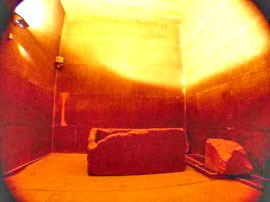 Unequivocally, our visit to
Giza and the Great Pyramid changed my
life. I do not make this statement lightly, especially in view of
all the incredible changes I’ve experienced since my health crisis
in 1979, and my subsequent thrust into the world as a visionary.
However, reviewing all the changes I’ve been through, my experience
at the Great Pyramid has had the most profound effect on my life and
direction of service of anything else I’ve experienced. Perhaps, as
Edgar Cayce said, "The Great Pyramid was built as a temple of
initiation." I certainly experienced my own visit as an initiation. Unequivocally, our visit to
Giza and the Great Pyramid changed my
life. I do not make this statement lightly, especially in view of
all the incredible changes I’ve experienced since my health crisis
in 1979, and my subsequent thrust into the world as a visionary.
However, reviewing all the changes I’ve been through, my experience
at the Great Pyramid has had the most profound effect on my life and
direction of service of anything else I’ve experienced. Perhaps, as
Edgar Cayce said, "The Great Pyramid was built as a temple of
initiation." I certainly experienced my own visit as an initiation.
Actually, many seers have pointed to the Great Pyramid as a place
for initiation. Some have even suggested its purpose was to
stabilize the world so as to prevent an axis shift. Scientists
continue to contend that it was a tomb for Khufu, though no mummy,
or records referring to the structure being a tomb for Khufu have
been found. Unlike other structures in Egypt, the Great Pyramid
contains no hieroglyphs that might shed some light on its purpose.
It appears that if the pyramid’s builders wanted to record any
message, they did so through the only process that would surely
survive — the massive size and ingenious mathematics of the
structure itself.
The visions I received at Giza were quite different from the visions
I’d otherwise been receiving since 1979. Typically, when I see a
vision it is like viewing a split screen, like watching two or three
aspects of the same scene. Not so at Giza. My first vision occurred
before I ever entered the pyramid. I was sitting on our balcony at
the Mena House, which faced the Great Pyramid, maybe a thousand feet
away, when I found myself seeing a vision of workers clearing the
plateau in preparation for construction of the Great Pyramid.
I found myself being drawn into the vision, so that instead of it
being an optical experience where I was viewing an event, I had
become part of the scene I was watching. I had actually traveled
back to the time of construction.
I see large birds in the air which remind me of prehistoric birds.
The terrain is much different than in my present — semi-tropical,
with lush vegetation, a mild temperature in the seventies, and water
surrounding the entire plateau. The area surrounding the hotel where
I had been when the vision began is now underwater.
Also in the air, I see large cigar-shaped flying machines which
resemble hot-air balloons. Cables hang down from the craft to anchor
points below. Workers dressed in white kilts and cloth hats that
have long flaps extending down to their shoulders, are removing
stones from cradles that are housed below the craft. The activity
reminds me of helicopters that transport heavy materials on
platforms, supported by cables. I can see other air ships coming
into the area, being guided by anchor cables from point to point.
Each ship carries a cradle, one stone in each, with markings on each
stone in glyph form. Here, I realize, is an unconsidered possibility
in the pyramid puzzle. These air machines were used to transport the
stones from quarries to the site — not barges, rollers, ramps and
slaves!
If this experience stops at this point, I tell myself, I will still
consider it the most amazing vision I’ve ever witnessed in my life.
I continue to watch the building of what will become — thousands of
years from now — one of the seven wonders of the world. Astounded, I
listen to the voices of the workers, and the screeches of the
mammoth birds in the sky. I bask in the humid heat of the day. My
thoughts are running so fast that I am barely aware of the throbbing
in my head — a familiar sensation which indicates I am pushing too
hard to receive information. I back off a little bit, and the
scenery changes.
Pictures began to flow by, like a river of consciousness. I
wondered, "When is this occurring?" Immediately, my inner voice
responded with an answer.
"The time frame is 12,553 years before present."
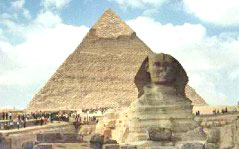 My thoughts dashed to a list of questions I had written for myself
back in New Hampshire, prior to our trip. During our travels, I had
hoped to find clues to the secrets of
the Sphinx and the Great
Pyramid itself — what their significance was, and answers to why I
had been drawn here. Now, here I was, tapped into a
super-consciousness database — a library of sorts — where I might do
a tad better than clues. Concerned time would run out and I would
lose the connection, my thoughts raced, but I was committed to
staying in this time-stream, and allowing whatever I was presented
with to occur. My thoughts dashed to a list of questions I had written for myself
back in New Hampshire, prior to our trip. During our travels, I had
hoped to find clues to the secrets of
the Sphinx and the Great
Pyramid itself — what their significance was, and answers to why I
had been drawn here. Now, here I was, tapped into a
super-consciousness database — a library of sorts — where I might do
a tad better than clues. Concerned time would run out and I would
lose the connection, my thoughts raced, but I was committed to
staying in this time-stream, and allowing whatever I was presented
with to occur.
"What was the
original significance of the Giza complex at the time
it was first built?"
"This would depend on which civilization, as the purpose varied
depending on the root race then present, for there have been many
evolutions there, and many groups have come and gone. In the
beginning, this country was one of the first of the in-dwellings of
man."
"What time frame?"
"Here we would need to turn back time to more than ten million years
from the present. The people were similar to a collective thought
form, physical in some respects, but light in density. If they were
viewed in the present they would appear shadow-like. The society was
one that was constructed or built upon a conscious relationship with
the One — in constant communication. It was taken for granted in the
same way a breath of air is taken for granted today.
"With the
greater changes and the shifts of the Earth’s axis —
numerous times — this site has been occupied longer than any other
land on the globe. In the time frame before the last geophysical
pole shift, some fifty-four thousand years ago, this site — Giza —
was occupied by the peoples from the Gobi who had moved into this
area and joined with the people already present. The
giant Olmec
heads that may be found in many lands today would be a close kin to
these people.
"After the shifting of the poles, this land became a wasteland of
sorts and eventually became overgrown, tropical in nature, and a
different geological formation. Even the oceans were much different
during this time period. Slowly the area shifted once more and
became more habitable, and then there were the migrations of those
peoples from Mu, Alta, and other lands that came into that region,
developing a high level of society some thirty-eight thousand years
before present. This would be termed here the beginning of the
current Giza site — not the first, mind you — for even during this
time period there was research going on to determine who the
original inhabitants of this land were.
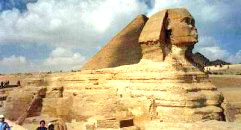 "During this time frame there began the construction of the first of
those monuments still present at Giza — the great head of the king
of that time which has since been modified into what is now called
the Sphinx. This was done by those who came into the land some
sixteen thousand years later. Civilization continued until there was
the greater destructive forces from the Atlantean land, thirty
thousand years before present, when there was the warring activity
between them and the land now known as China. This caused global
cataclysm, bringing the world into another dark age. "During this time frame there began the construction of the first of
those monuments still present at Giza — the great head of the king
of that time which has since been modified into what is now called
the Sphinx. This was done by those who came into the land some
sixteen thousand years later. Civilization continued until there was
the greater destructive forces from the Atlantean land, thirty
thousand years before present, when there was the warring activity
between them and the land now known as China. This caused global
cataclysm, bringing the world into another dark age.
"This site lay dormant and did not reemerge again until
approximately eighteen thousand years ago. At this time we would
find the beginning of what was to become a solar cult, and the
beginning of the current Egyptian civilization. Growth was slow
until twelve thousand five hundred years ago, when other races of
people from Zu, Ur, Dar, and Alta, entered into this land. It was
during this time period that great technological, spiritual and
scientific advancements were achieved on Earth. Here began the
initial thoughts and plans for what was to become a series of
complexes, above and below ground: a great avenue containing
buildings dedicated to science, medicine, history, astronomy; an
observatory; buildings dedicated to astrology and numerology;, and
more. Today it would be similar to the Library of Congress, the
Smithsonian, the Cairo Museum, the Mount Palomar Observatory, and
various universities.
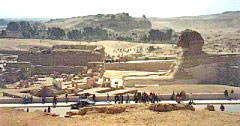 "Now, during this time frame, the Nile was much closer to the
complex and there were canals that had been dug allowing the Nile to
reach the site. So, from the Sphinx, for example, we would find the
Nile to be five hundred to a thousand yards, depending upon the turn
or the curve of the waterway. This channeled water into the site and
the plateau could be seen as an island unto itself. Whereas, if you
looked at the plateau now, you would find that the area that is now
the ancient cemetery, as well as the new cemetery, situated to the
east and facing the Sphinx, would have been a waterway. So imagine
an island, rectangular in shape, with a docking port many feet below
and on the east and west sides of the Sphinx. This would give you a
fair approximation of the site during this time period." "Now, during this time frame, the Nile was much closer to the
complex and there were canals that had been dug allowing the Nile to
reach the site. So, from the Sphinx, for example, we would find the
Nile to be five hundred to a thousand yards, depending upon the turn
or the curve of the waterway. This channeled water into the site and
the plateau could be seen as an island unto itself. Whereas, if you
looked at the plateau now, you would find that the area that is now
the ancient cemetery, as well as the new cemetery, situated to the
east and facing the Sphinx, would have been a waterway. So imagine
an island, rectangular in shape, with a docking port many feet below
and on the east and west sides of the Sphinx. This would give you a
fair approximation of the site during this time period."
"Was the Great Pyramid like a church
or temple, where people came to
pray for enlightenment or experience initiation?" I asked.
"You seek a name to call this structure, a name to describe its
purpose, do you not?"
Still somewhat fearful that I would loose the contact, I thought,
trying not to be too excited, "Yes, that’s exactly it."
An immediate response came back. "The Great Pyramid is a time
machine."
This response was not one of the possibilities I had considered! How
could it be possible? Television and movies in the present are just
beginning to explore the possibilities of time travel. For
comparison, look at what we have achieved in the past century —
electricity, the automobile, atomic power, lasers, space travel —
all within the short span of a hundred years. Now, imagine where our
civilization might be in the next hundred years. And that is exactly
where these people were over twelve thousand five hundred years ago!
Civilization does not necessarily develop technologically, with
time. Rather, it rises and falls, depending on the lessons that
civilization — that particular group consciousness — desires.
"Who built the Great Pyramid?" I asked.
"Atlanteans, in conjunction with Egyptians and
Dareans."
"How does this machine work?"
"The machine’s purpose, as constructed, was multiple in design.
Bending time was its focus, so as to provide a process for
initiation. However, the manner in which this was accomplished
provided other benefits for its people. These varied from increased
crop yield, weather control, a form of electrical power, and a
learning institute for the study of the heavens — astronomy,
astrology and cosmic forces, mathematics, chemistry, inner world
dimensions, and the seven levels of initiation. All were part of its
design."
"Like astronomy and astrology," I thought.
"Yes, it was used as an observatory. The builders knew the cycles of
the stars, their individual and collective emanations relative to
the Earth and sun, their effect on consciousness, and the fact that
life was not limited to the Earth. To this end, windows were known
and so recorded in those chambers, known and unknown, to indicate
times when communication was possible with people from other worlds
— both inner worlds and physical worlds. Knowing these things then,
it became possible to construct such an instrument that could attune
to those forces emanating from stars and other dimensions, amplify
and modify them so as to bend time. This then allowed those in
resonance with the instrument to enter the time-stream where all
inner-world communication occurs relative to this sphere."
"What did these people hope to attain through time traveling?"
"A way to
communicate with the Lord and His angels."
Stunned by this answer, I felt the familiar electrical sensations
course through my body, and suddenly found myself back on the hotel
patio. I was intensely disappointed that my lack of control had
caused me to break the contact. My head throbbing from the
experience, I decided I would try again the next day, and fell
asleep for the afternoon.
Realizing the importance of timing and consistency regarding
intuitive applications, I attempted to induce a vision the next day
at the same time and location. Colorful visions emerged, showing me
the topography of the region, the position of the Nile at that time,
and more views of the construction process. These were the more
conventional visions that I usually receive — more of visions
blending into other visions — each lasting only seconds. After
fifteen minutes or so, these stopped.
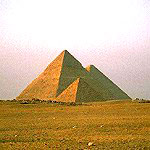 Later that day we visited
the Sphinx, where we spent an hour or so.
Upon leaving the Sphinx area I walked to the top of the plateau
where the Great Pyramid and two smaller pyramids — those for Kings
Mycerinus (or Menkaure) and Chephren (or Khafre) — are located. I
stopped at a turn in the road, about a thousand feet away, and gazed
at the three pyramids, enjoying their magnificence. Suddenly, I
heard a popping sound, and found myself once again witnessing the
construction of the Great Pyramid. The experience of the previous
day had prepared me, or rather focused my thoughts towards what I
felt was important to observe. I never expected to repeat the
interactive experience, but hoped I would be able to go back to the
point I’d left at the day before. Later that day we visited
the Sphinx, where we spent an hour or so.
Upon leaving the Sphinx area I walked to the top of the plateau
where the Great Pyramid and two smaller pyramids — those for Kings
Mycerinus (or Menkaure) and Chephren (or Khafre) — are located. I
stopped at a turn in the road, about a thousand feet away, and gazed
at the three pyramids, enjoying their magnificence. Suddenly, I
heard a popping sound, and found myself once again witnessing the
construction of the Great Pyramid. The experience of the previous
day had prepared me, or rather focused my thoughts towards what I
felt was important to observe. I never expected to repeat the
interactive experience, but hoped I would be able to go back to the
point I’d left at the day before.
There are no pyramids present on the plateau, only the beginning
construction of what will be the Great Pyramid. I recognize the
Sphinx, although the styling is much different than in my present;
there are a few other buildings, as well, rectangular in shape, and
a few mound-like structures that seem to be very old. The monstrous
birds I’d seen in my previous visions continue to fill the sky. I
notice several men making strange motions. In one hand, each holds a
sling of some sort, which carries a weight at one end. They begin
spinning these in a circular fashion. A high-pitched screech is
emitted, causing the prehistoric birds to scatter, and me to cover
my ears. A few moments later, a large air ship enters the plateau.
I prayed I could keep centered and stay as an "observer." I took a
deep breath, and felt an electrical sensation run from my shoulders
to my neck. Carefully, I asked my first question.
"What is the relationship between the Great Pyramid being both a
time machine and a place of initiation?"
"Life is initiation. Each thought, each action, is a portion of
initiation. Man once walked the Earth with full knowledge of the
Oneness. All thoughts were one. All actions one. Then, with a single
thought, an infinite number of thoughts — separate and collective —
were formed. It was the creation of souls. A portion of these souls
came to this sun system to experience individuality, though they
remained connected to the Host. With time, magnetic forces and will,
communication with the Host and other spiritual realms became so
blocked as to cause a separation. To aid in the reconnection, a
process of initiation, or training, was established. It utilized the
Great Pyramid as a communications instrument. In this way, contact
would be possible for those who, through their dedication, could
communicate with their soul mates and the greater collective
consciousness."
So many questions were part of my consciousness, but I grabbed onto
the first one I could, so as not to loose the connection again.
"Why
so large a structure?"
"The size and mass chosen was required in order for the instrument
to contain the gasses within the structure, as the machine operated.
The shape chosen, acted as an antenna — collecting those particles
that precede light from the heavens, that are forever being drawn to
this sphere."
"Could you explain the term ‘antenna’?"
"This specific pyramid shape, in conjunction with its position of
latitude, acted as a lens, not optical, but in focus, drawing to the
machine those rays necessary for communication."
"Explain what is meant by ‘gasses within the structure’?"
"Stones in specific portions of the instrument were set in place
with a sealer-adhesive, which allowed for airtight chambers and
passageways to exist. The gasses were a mixture brought up from deep
within the Earth, and combined with gasses created by the alteration
of elements, as created through the instrument. The principles used
here are similar to the laser used today, but developed differently
because of conditions then present."
"Was this gas invisible?"
"Green in color when active, invisible otherwise."
"Is this gas present in the world today?"
"Only at times in nature when those
magnetic vortexes that may be
found in the world become active."
"What is meant by ‘active’?"
"Transition points — polarity shifts in the solar cycle — June and
December currently."
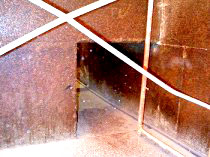 "And what is the purpose of the passageways?" "And what is the purpose of the passageways?"
"Multiple in purpose. These were used as service tunnels, sighting
tubes, and to channel large quantities of gas to the appropriate
chamber."
"And what about the main entrance to the ascending and descending
passageways?"
"The main entrance has not been found. It will be discovered deep
below the base — nearer the center of the pyramid — with a
passageway leading up to the apex, as well as to the Sphinx and
other structures. What is now thought to be the main entrance, was
at that time used as part of the machine. At that time, a hinged
door was set in the opening which, in one mode of operation, acted
as a safety valve for the release of gas. In another mode, the door
was held open by a lever, allowing the sighting and tracking of
specific stars. This was so the Earth’s exact position, or axis
relative to specific spheres — currently Polaris — could be
determined. When used for such alignment, light from the star
entered the doorway and fell upon the instruments, located at a
position along the descending passageway."
"If the entrance was below the base, how did one get to the
Queen’s
and King’s Chambers?"
"Access to these chambers were not required as
they were a portion
of the instrument — harmonically-tuned rooms. By way of a stone
staircase, travel to the top — or capstone — was possible, as was
travel to the lower control rooms many hundreds of feet below."
"So there was a capstone?"
"Yes, made out of the metals of the day — hollow."
"Are there other chambers above the base besides those we know as
the King’s and Queen’s Chambers, and the Pit?"
"Yes. Seven in number, above the base as chambers."
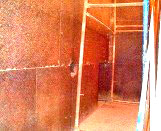 "What is the purpose of those shafts found in the
Queen’s Chamber?" "What is the purpose of those shafts found in the
Queen’s Chamber?"
"These are for monitoring and controlling the gasses, internal to
the structure at that location."
"What is the purpose of the
Grand Gallery?"
"This is the tuning circuit of the instrument. Along its length,
tracks were fitted — above, below and on each side — in which a
tuning device was housed, in a carriage. The carriage, then,
contained the likeness of a creature — part bird, part beast —
holding a large crystal in its talons. The tips of the creature’s
wings reached to the height of the Gallery, and contacted the upper
tracks. This was then powered, through induction, by magnetic
forces. These propelled the carriage up or down the Gallery. When
tuned properly — for depending on the chamber selected, different
desired results could occur — the time-space fabric would shift
within the instrument, allowing a portal to open."
My head continued to throb as vision after vision filled my mental
screen. The realization of what I was experiencing began to
overwhelm me. My first thought was to give control of what was
occurring over to some external force. But my inner voice responded,
correcting me in a gentle, yet assertive manner.
"You are aware most times of the real you and your connection with
the inner worlds. You must now push your consciousness out further,
and acknowledge the experience as being within. Do not
misunderstand. This is not to indicate that other spiritual forms
are not assisting, or are at times present, but these occur as
guides to assist in initiation, not to fulfill initiation. The more
the inner self is accepted, the greater the development. And yes ...
risk is the price that must be paid. But what is being risked here?
We would suggest it is the ego. Without risk, there can be no gain.
Safety is but an illusion."
I took a few deep breaths. I thought, I know this, so why do I
continue to question, to resist? I felt a glimmer of understanding.
It is part of the initiation, I thought. My mind relaxed, and I
continued with my questioning about the Great Pyramid.
"Who, or what, determined the selection of a chamber?"
"The initiate chose, with the assistance of the
priest."
"Please explain this."
"Better here to explain initiation. As given previously, all of life
is initiation. Each experience, each act, each deed — especially
thoughts — are a portion of initiation. Initiation then is a process
whereby the entity — the soul force — is given the opportunity to
develop spiritually. This means, that when the soul chooses to
improve itself — to move towards a greater light, the soul-body so
changes its vibration as to remove from its spiritual fabric those
attachments detrimental to its path upward.
"An analogy here would be to imagine blindness that has been a part
of the physical body from birth. Then, through surgery and the
removal of blockages, vision is very slowly restored. At first,
light may be detected, void of detail or meaning, but nevertheless,
a new experience. Slowly, shadows appear in the vision. Another new
experience. Shadows then give way to form and detail. With each new
visual experience, small shifts in awareness occur. Lastly, color
fills the form and a new interaction with the other senses occurs.
At this point, a whole new world opens up — the applications of
sight. Initiation operates much in the same manner.
"Now as to the process of initiation. Each soul is at some level of
initiation at birth, as a result of previous, as well as future,
incarnations. Even those souls who have fallen are still at a level
of initiation. Initiation can be either an upward movement towards a
greater light or downward towards the darkness."
"Are the two known passageways — ascending and descending — related
to initiation?"
"Descending — to decline or regress. Ascending — upwards towards the
Great Hall and final initiation in the King’s Chamber."
"It has been speculated in some books that these passageways contain
evidence of Biblical prophecies. Is this correct?"
"In part. The passageways contain a time line. This marks
significant dates of all major religious movements since man first
entered the Earth. The time line ends in 1953, with the entrance to
the King’s Chamber."
"Why 1953?"
"This marks the time period of ‘the choosing.’ The choices of
humankind, from 1953 to 1998, will determine how the development of
the next civilization, or root race, will unfold."
"Does the time line pick up somewhere else?"
"Rather, it points the way."
"To where?"
"The tomb."
"Does this refer to the empty sarcophagus?"
"Yes, though this was part symbolic, in form, and part of the
machine."
"What does it symbolize?"
"The final test — passage from the physical world to the spiritual
and back. The continuum of life."
"And how is this part of the machine?"
"It is a resonant device tuned to the frequencies required for the
seventh level of initiation. This then worked in conjunction with
the room’s additional workings. What appears to be the ceiling of
the King’s Chamber is but one of several tuned circuits. Forces
collected by the pyramid were captured, focused and directed
downward through the stones, into the open sarcophagus. These
frequencies, in conjunction with other forces created by
the crystal
in the Great Hall, and the initiate himself, made possible the test
for the seventh level of initiation — travel to other worlds."
"So the sarcophagus by itself has no power?"
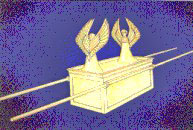 "In the hands of an initiate of the seventh level it has great
power, even today." "In the hands of an initiate of the seventh level it has great
power, even today."
"Are there other devices like this in the world?"
"The one most remembered and still preserved is known as the ‘Ark of
the Covenant’."
I decided, despite my curiosity to know more about this, that I
would make better use of this opportunity by staying with the
subject of initiation. I hoped that some day I would be able to
learn about the Ark, and some of the other areas touched upon. I
continued with the original line of questioning.
"Since the initiates were not physically present in the chambers,
how was travel to other worlds possible?" …
…The above text was excerpted from time traveler/futurist
Gordon-Michael Scallion’s book
Notes from the Cosmos available
through most booksellers,
www.amazon.com or Mr. Scallion’s web site:
www.matrixinstitute.com
|
 Considered one of the seven wonders of the world, the
Considered one of the seven wonders of the world, the
 The
Great Pyramid is constructed of almost two and a half million
blocks of stone, each weighing at least two tons, with some stones
estimated at over fifty tons. (For comparison, the average weight of
an American automobile is approximately two tons.) These massive
blocks were cut, moved, and then fitted together with such exactness
that a thin blade cannot be inserted between them. The pyramid has a
vertical elevation the equivalent of a forty-story skyscraper — over
four hundred feet. Currently, no capstone exists on the structure,
and much debate exists as to whether one ever did exist. The base of
this massive monument measures over seven hundred fifty feet on each
of its four sides, and covers an area of thirteen acres. (Again, as
a comparison, an average city block in New York City covers just
under two acres.) The four sides of the pyramid are perfectly
oriented towards the cardinal points — north, south, east, and west.
The base is level with a divergence of less than one inch in its
total circumference.
The
Great Pyramid is constructed of almost two and a half million
blocks of stone, each weighing at least two tons, with some stones
estimated at over fifty tons. (For comparison, the average weight of
an American automobile is approximately two tons.) These massive
blocks were cut, moved, and then fitted together with such exactness
that a thin blade cannot be inserted between them. The pyramid has a
vertical elevation the equivalent of a forty-story skyscraper — over
four hundred feet. Currently, no capstone exists on the structure,
and much debate exists as to whether one ever did exist. The base of
this massive monument measures over seven hundred fifty feet on each
of its four sides, and covers an area of thirteen acres. (Again, as
a comparison, an average city block in New York City covers just
under two acres.) The four sides of the pyramid are perfectly
oriented towards the cardinal points — north, south, east, and west.
The base is level with a divergence of less than one inch in its
total circumference.

 My thoughts dashed to a list of questions I had written for myself
back in New Hampshire, prior to our trip. During our travels, I had
hoped to find clues to the secrets of
My thoughts dashed to a list of questions I had written for myself
back in New Hampshire, prior to our trip. During our travels, I had
hoped to find clues to the secrets of
 "During this time frame there began the construction of the first of
those monuments still present at Giza — the great head of the king
of that time which has since been modified into what is now called
the Sphinx. This was done by those who came into the land some
sixteen thousand years later. Civilization continued until there was
the greater destructive forces from the Atlantean land, thirty
thousand years before present, when there was the warring activity
between them and the land now known as China. This caused global
cataclysm, bringing the world into another dark age.
"During this time frame there began the construction of the first of
those monuments still present at Giza — the great head of the king
of that time which has since been modified into what is now called
the Sphinx. This was done by those who came into the land some
sixteen thousand years later. Civilization continued until there was
the greater destructive forces from the Atlantean land, thirty
thousand years before present, when there was the warring activity
between them and the land now known as China. This caused global
cataclysm, bringing the world into another dark age. "Now, during this time frame, the Nile was much closer to the
complex and there were canals that had been dug allowing the Nile to
reach the site. So, from the Sphinx, for example, we would find the
Nile to be five hundred to a thousand yards, depending upon the turn
or the curve of the waterway. This channeled water into the site and
the plateau could be seen as an island unto itself. Whereas, if you
looked at the plateau now, you would find that the area that is now
the ancient cemetery, as well as the new cemetery, situated to the
east and facing the Sphinx, would have been a waterway. So imagine
an island, rectangular in shape, with a docking port many feet below
and on the east and west sides of the Sphinx. This would give you a
fair approximation of the site during this time period."
"Now, during this time frame, the Nile was much closer to the
complex and there were canals that had been dug allowing the Nile to
reach the site. So, from the Sphinx, for example, we would find the
Nile to be five hundred to a thousand yards, depending upon the turn
or the curve of the waterway. This channeled water into the site and
the plateau could be seen as an island unto itself. Whereas, if you
looked at the plateau now, you would find that the area that is now
the ancient cemetery, as well as the new cemetery, situated to the
east and facing the Sphinx, would have been a waterway. So imagine
an island, rectangular in shape, with a docking port many feet below
and on the east and west sides of the Sphinx. This would give you a
fair approximation of the site during this time period." Later that day we visited
the Sphinx, where we spent an hour or so.
Upon leaving the Sphinx area I walked to the top of the plateau
where the Great Pyramid and two smaller pyramids — those for Kings
Mycerinus (or Menkaure) and Chephren (or Khafre) — are located. I
stopped at a turn in the road, about a thousand feet away, and gazed
at the three pyramids, enjoying their magnificence. Suddenly, I
heard a popping sound, and found myself once again witnessing the
construction of the Great Pyramid. The experience of the previous
day had prepared me, or rather focused my thoughts towards what I
felt was important to observe. I never expected to repeat the
interactive experience, but hoped I would be able to go back to the
point I’d left at the day before.
Later that day we visited
the Sphinx, where we spent an hour or so.
Upon leaving the Sphinx area I walked to the top of the plateau
where the Great Pyramid and two smaller pyramids — those for Kings
Mycerinus (or Menkaure) and Chephren (or Khafre) — are located. I
stopped at a turn in the road, about a thousand feet away, and gazed
at the three pyramids, enjoying their magnificence. Suddenly, I
heard a popping sound, and found myself once again witnessing the
construction of the Great Pyramid. The experience of the previous
day had prepared me, or rather focused my thoughts towards what I
felt was important to observe. I never expected to repeat the
interactive experience, but hoped I would be able to go back to the
point I’d left at the day before. "And what is the purpose of the passageways?"
"And what is the purpose of the passageways?" "What is the purpose of those shafts found in the
Queen’s Chamber?"
"What is the purpose of those shafts found in the
Queen’s Chamber?" "In the hands of an initiate of the seventh level it has great
power, even today."
"In the hands of an initiate of the seventh level it has great
power, even today."